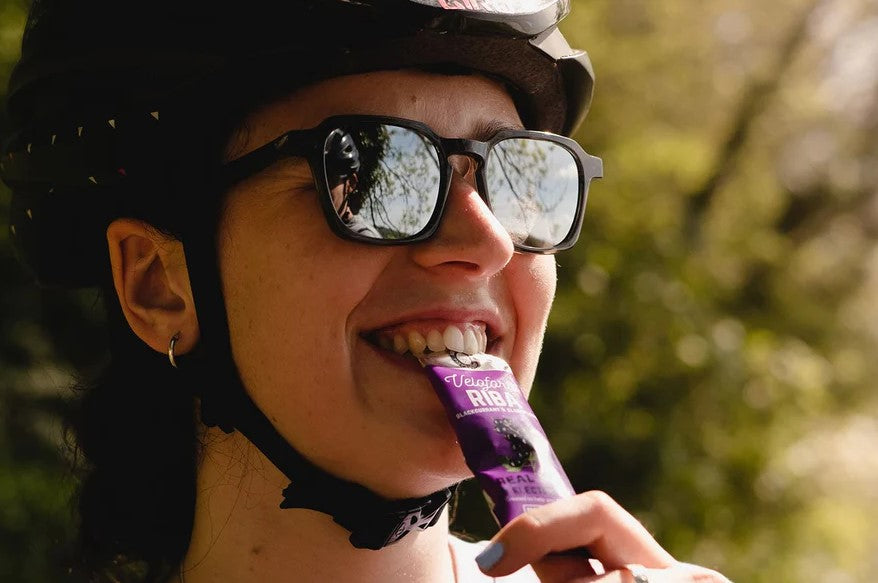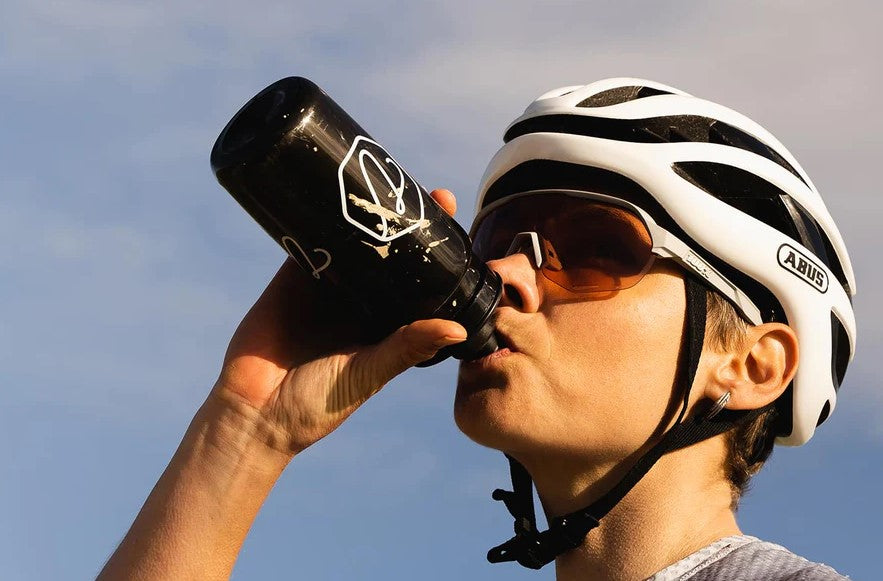Best Energy Bars for Runners: Here’s How to Choose

There’s more than one way to fuel a runner. While energy gels, energy chews and energy drinks all have their place in our running fuel kit, energy bars can also be great for pre-fuelling, topping up carbs on longer, slower runs and as a convenient way to boost rapid recovery.
But not all energy bars are created equal and choosing the right bar – at the right time – can be a bit of a minefield. Don’t worry, though, when it comes to nutrition, here at Veloforte we’ve got you covered.
Here’s our complete guide to the best energy bars for runners.
Download the ebook above.
Types of energy bars for runners
Carbohydrate bars
Packed full of your body’s go-to fuel, carbohydrate bars are a great source of portable energy for runners. They’re ideal as a pre-run top up on the way to the start line. Or on longer endurance runs where you might want a solid-food alternative to energy gels, drinks and chews.
Each bar in Veloforte’s Endurance Bar pack gives you a big bang-for-buck 40g of carbs per 60g.

Low-calorie bars
Primarily a tool for weight management, low-calorie bars tend to have less than 200 calories per bar, lower levels of carbohydrate and often very little nutritional value. They can also be high in artificial nasties. They’re mainly targeted as a healthy snack and not much use for runners who need to adequately fuel exercise or recovery.
Protein bars
Protein bars are typically designed as a convenient way to support muscle repair after exercise. They come with various different ratios of protein, fat and carbs and wildly differing levels of sugar and additives.
The best recovery protein bars for runners have a 3:1 ratio of carbs to complete proteins. With the carbs there to restock fuel tanks and support the uptake of that muscle repairing protein.
Veloforte Forza and Mocha protein bars tick all the right recovery-boosting, nutritional boxes. They also get all of their goodness from real food ingredients and taste great. So you actually want to eat them once you step outside the pain cave. Not all protein bars can claim that.

Meal-replacement bars
Meal replacement bars aim to be a quick, convenient and balanced source of carbs, protein, fat and vital vitamins and minerals. While they can plug a gap if you're tight on time, or travelling – for example to a race start – they’re best used sparingly. Nothing beats real food in a well-balanced diet.
How to choose the best running energy bar for you
Optimising your running nutrition is a personal pursuit. What works for your super-fast, ultra-running friend might not work for you. But there are some basic principles you can follow that’ll make it much easier to spot the good from the not-so-good stuff when you’re choosing the best bar for your running workout.
Natural vs. synthetic energy bars for runners
At Veloforte we believe real food is always a better option than heavily processed and synthetic foods. Energy from natural sources is more appealing, tastier and more enjoyable to eat. Eating real food can help ward off painful bloating, wind and the stomach upsets that are common with synthetic bars.

Natural sugars vs. artificial sugars
Sugar substitutes can play havoc with your digestive system and artificial sweeteners found in low-calorie bars upset your body’s natural insulin response to sugar.
The big hit of carbohydrates in Veloforte’s natural energy bars comes from real-food ingredients like dried fruits, natural syrups and whole foods. That fruit fructose sugar works with the glucose to create a steady, sustained, dual fuel that helps you absorb the maximum amount of energy.

Natural taste vs. synthetic taste
How many times have you reached that point in a run where it’s time to eat but you find yourself delaying because you’re dreading another onslaught of artificial flavour? Us too.
It sounds obvious to say this but we know that you’ll fuel better with foods that taste delicious. If a bar is tasty, not only are you much less likely to under-fuel, but you can turn moments of struggle into psychological treats. And who doesn’t need that six hours into a mountain ultra!

Best energy bars for runners: The Veloforte buyer’s guide
Now you know what to look out for when choosing the best healthy energy bars for runners, let’s take a look at the Veloforte range of energy and protein bars, their different flavours and benefits:
Classico Energy Bar

A dual-source of carbohydrates, the Classico energy bar is flavoured with zesty citrus fruits, almonds, and honey. It’s free from nasties like sulphites, additives and preservatives. It’s also a gluten-free source of zingy natural energy with a tasty, chewy, yet slightly crunchy texture.
Avanti Energy Bar

The gluten-free and vegan-friendly Avanti combines dates, pecans, and sea salt for a fruity and nutty kick. Natural sea salt helps balance your electrolytes. Soft, chewy, and slightly salted, it’s great for restocking carbohydrates on longer runs.
Zenzero Energy Bar

Another gluten-free, vegan-friendly dual-source of carbohydrates. If you want an option to calm your digestion, the nutty and zesty Zenzero is it. It combines Sicilian lemons, pistachios and stomach-settling ginger in a bar that wakes your senses. So it’s great for a fresh boost before your run.
Ciocco Energy Bar

Packed full of dates, almonds and cocoa, if you love chocolate, this bar belongs in your running belt. Definitely one of the more indulgent treats for long hauls on the tarmac and the trails, it’s gluten-free and a great source of dual-fuel carbs. Save this one for when you really need a pick-me-up.
Di Bosco Energy Bar

The award-winning Di Bosco is crammed full of red berries, almonds, pistachios, and rosemary in a soft, chewy plant-based bar. It’s gluten-free, vegan-friendly and delivers our perfectly balanced package of delicious, powerful and nutritious dual-fuel energy.
Energy bars for post-run recovery
Mocha Protein Bar

One for the coffee lovers, the Mocha Protein Bar blends crunchy hazelnuts with smooth flavours of coffee, dates, and cocoa to produce the ultimate refuelling bar. Each bar provides 10g protein and 37g carbs in a 4:1 ratio, so it’s the perfect snack to restock empty fuel tanks and kick-start your muscle recovery.
Forza Protein Bar

Another excellent combination for refuelling and recovery, the apricot, almond, and fennel flavours in the Forza bar set you up with a 3:1 ratio of carbs to protein in a gluten-free package. The Forza’s protein comes from highly digestible egg whites to help speed recovery. Not vegan, but a superpowered vegetarian recovery bar.
Energy bar usage guide for runners
When should you eat energy bars?
In theory, energy bars can be used to fuel any run. However, the shorter, faster or harder you’re running, the less likely you are to be able to eat – let alone digest – this solid fuel source. That’s why we have our power-packed energy gels.
But there are moments when it pays to incorporate an energy bar into your fuelling. Here are three of the best:
Pre-run
Energy bars can be a great go-to for those times when you need to top up your stores but you don’t have the time before a run.
For example, when time is tight or logistics make breakfast tricky. Or if you’re running home after work and you need a little more than the lunch you ate. Just give yourself enough time to digest.

Mid run on longer, lower intensity runs
Think 3-hour marathon training runs where you’re moving at a low heart rate. Or ultra runs where you’re really out to enjoy a moving picnic.
These are times when it’s practical to open a bar and be able to chew and your intensity is low enough that your stomach can do its thing.

Post-run after longer, harder runs
Running long or hard heightens your recovery needs. That’s when you reach for a protein bar with that golden 3:1 ratio of carbs to protein, to replenish glycogen stores and give your muscles the building blocks for repair.
Need more help with your post-run routine? Check our running recovery tips for more ways to bounce back faster.

How often should you eat energy bars on a run?
Generally speaking, the body will absorb energy gels more rapidly than energy bars because there’s less digesting to be done. Bars are not only more food in the stomach, they tend to pack more carbohydrates too. So you’re unlikely to be smashing bars at the same rate as you might gels.
As a rule, after the first 90 minutes (which are powered by your glycogen stores), your body can absorb 60g-90g of carbohydrate per hour. That’s 1.5 to 2 of Veloforte’s energy bars. That’s quite a lot to eat, so in reality, you’ll want to use a mix of fuels to hit your refuel rates.
The great thing about energy bars is that you can eat them in smaller bites and stick them back in your pocket. On runs where the intensity allows, we’d recommend nibbling on a third of a bar every 20 minutes or combining them with gels, drinks and other sources of fuel. Trial and error are crucial to find out what balance works for you.

Get started with running energy bars
Hopefully you’re now armed with all the info you need to know when, how and which energy bars to add to your running fuel mix. Now it’s time to stock up on our range of energy bars, protein recovery bars and do some testing.
Here at Veloforte, we always recommend testing fuelling options in training, so you can find out what works best for you. Or, if you’re looking for a delicious vegan way to fuel your runs and recover, we’ve also got a vegan energy bar selection, too. If you’re looking for the best energy bars for marathon runners, try our family box.

